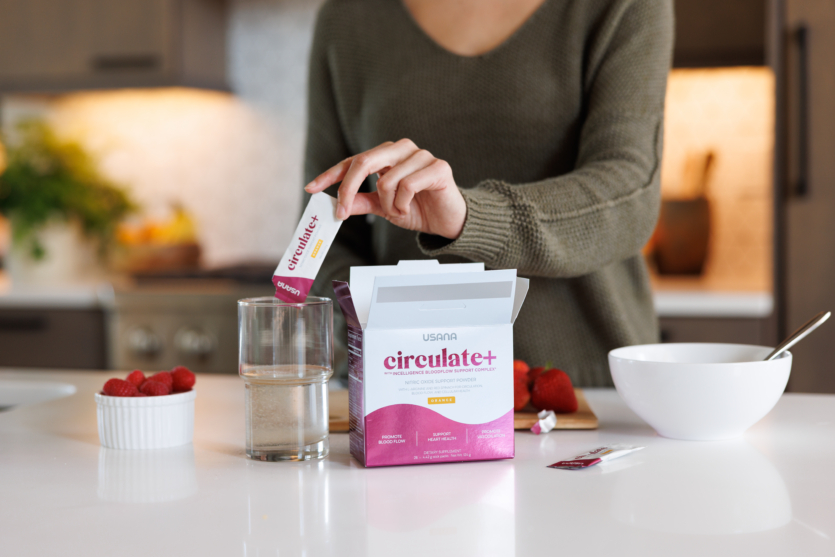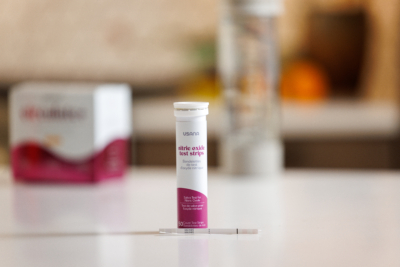Promote Healthy Circulation with USANA Circulate+
Maintaining healthy circulation is important to your cardiovascular health and overall wellbeing. A healthy diet, regular exercise, and wholesome habits can affect good blood flow. For an extra boost, USANA Circulate+ drink mix can provide you with ingredients rich in nitric oxide (NO), sustaining circulation and overall cellular health.
Circulate+ enhances nitric oxide production to promote the following:
- Vasodilation: “Vaso” refers to blood vessels and “dilation” means widening. Therefore, vasodilation refers the widening of blood vessels, allowing more blood to flow through them. NO helps with vasodilation by relaxing and widening blood vessels, improving blood flow and reducing blood pressure.
- Immune Response: NO helps support robust immune function and a healthy immune response.
- Antioxidant Effects: NO helps protect blood vessels from oxidative stress and free radical damage.
- Exercise Performance: Increased NO can help blood flow and oxygen delivery to muscles, improving performance and reducing muscle fatigue.
- Neurotransmission: Effective neurotransmission is important for brain function and overall nervous system health. NO can act as a neurotransmitter, facilitating communication between neurons (nerve cells).
- Wound Healing: NO supports various aspects of wound healing, including inflammation.
- Maintaining Healthy Inflammation: By helping your body maintain a normal and healthy inflammation within the vascular system, nitric oxide supports cardiovascular health and maintains arterial health.
The nitric-oxide rich ingredients in Circulate+ can help you sustain performance and support overall health. But what is nitric oxide and how is it produced in your body?
The Benefits of Increased Nitric Oxide in the Body
Nitric oxide is a free radical characterized by an unpaired electron, which makes it highly reactive. Unlike most free radicals that are neutralized by antioxidants to prevent cellular damage, NO is unique due to its essential roles in the body. It is considered the body’s only known healthy free radical because of its positive effects on various physiological processes.
Nitric oxide is a molecule composed of one nitrogen atom and one oxygen atom. The body produces NO through two main pathways:
- Reducing dietary nitrates to nitrites and then to nitric oxide, especially under low oxygen conditions such as during intense physical activity.
- Converting the amino acid L-arginine into nitric oxide using the enzyme nitic oxide synthase (NOS)
The ingredients of Circulate+ utilizes both these pathways to support your body’s natural ability to produce nitric oxide.
Support Nitric Oxide Production with Red Spinach Extract
Nobody understands the benefits of spinach quite like the character Popeye. While consuming spinach will not have the same instantaneous results as portrayed by the cartoon sailor, spinach offers several benefits that apply to reality.
Leafy greens like spinach are excellent sources for boosting nitric oxide levels. The body converts the compounds in spinach into nitric oxide through the following process.
- Nitrate (NO3): Nitrate is a compound with one nitrogen atom and three oxygen atoms. When consumed, nitrates are absorbed in the gut and concentrated in the salivary glands.
- Nitrite (NO2): Bacteria in the mouth convert nitrates in the salivary glands to nitrites, which are compounds with one nitrogen atom and two oxygen atoms. These nitrites are then swallowed with saliva.
- Nitric Oxide (NO): The acidic environment of the stomach reduces nitrites to nitric oxide which can then enter the bloodstream and exert its various physiological effects, such as maintaining blood flow and supporting cardiovascular health.
The red spinach extract in Circulate+ is included for its high nitrate content. The increased nitric oxide levels from the red spinach extract can help support endurance, athletic performance, and muscle growth and recovery.
Convert Nitrates to Nitric Oxide with L-arginine
The body also produces nitric oxide through the enzyme nitric oxide synthase (NOS) using the amino acid L-arginine. A synthase is an enzyme that joins two molecules together—in this case, L-arginine and molecular oxygen—to form nitric oxide. This process takes place throughout the body and involves three main distinct forms called isoforms:
- Endothelial NOS (eNOS): Found in the cells lining blood vessels, eNOS regulates blood pressure, blood flow, and causes vasodilation.
- Neuron NOS (nNOS): Found in the nervous system including brain and peripheral nerves, nNOS helps with neurotransmission, synaptic plasticity (the ability of neurons to change the strength of their connections which plays a key role in memory storage), and regulation of blood flow in the brain.
- Inducible NOS (iNOS): Found in various cell types, particularly immune cells, iNOS helps support strong immune cells and regulate normal inflammatory responses.
L-arginine is considered semi-essential, meaning that while the body can produce it, additional amounts may be needed from dietary sources or supplements. Circulate+ is one such supplement that can provide additional L-arginine to support nitric oxide production.
Maintain Health with Antioxidants from Grape Seed Extract
The benefits of grape seed extract have long been utilized in health supplements due to its high antioxidant content. Grape seed extract has been shown to enhance blood flow, protect against oxidative stress, and support healthy inflammation. It is also a main ingredient in USANA’s Proflavanol C health supplement. In Circulate+, the antioxidant properties combine with red spinach extract and L-arginine to support vasodilation, circulatory functions, and immunity.
Maintain Healthy Circulation with Circulate+
Supporting your circulatory system is fundamental to your overall health. The ingredients in Circulate+ are designed to sustain nitric oxide production in the body, which supports vasodilation, circulatory functions, immunity, and overall cellular health. By maintaining better blood flow and reducing oxidative stress, Circulate+ helps your body function at its best.
Key Ingredients
- Red spinach extract
- L-arginine
- Grape seed extract
Usage
Add one (1) stick pack to 8–10 oz. water (or to taste), mix thoroughly, and enjoy.
Circulate+ Test Strips FAQ
What are Nitric Oxide Test Strips?
Nitric oxide test strips are a convenient, fast, and non-invasive way to estimate your body’s nitric oxide (NO) levels. They are useful for tracking cardiovascular health, the state of the oral microbiome, and certain aspects of diet and fitness.
How do the test strips work?
The test strips measure nitrite levels in your saliva, which are a byproduct of dietary nitrates and a precursor to nitric oxide.
When the strip comes into contact with saliva, it reacts chemically and changes color. You can then compare the resulting color to a chart that is provided with the strips.
Why do dietary nitrates matter?
When foods rich in nitrates (beets, spinach, leafy greens) are consumed, the nitrates are converted to nitrites by oral bacteria. These nitrites are then converted to nitric oxide in the body which helps support healthy blood pressure, blood flow, and overall cardiovascular fitness.
What are the benefits of using the strips regularly?
The strips can be used as a tool to
- Track the impact of nitrate-rich foods in the diet and their impact on the oral microbiome
- Indicate oxygen availability to help optimize workouts
- Provide early insights to potential health problems
- Incentivize dietary and fitness improvements
What is the best way to use test strips?
Test at regular times for the most reliable tracking. You should avoid brushing your teeth, eating, or drinking anything except water for at least 30-60 minutes before testing. Use of antibacterial mouthwash will also disturb and negatively affect the oral microbiome needed to convert nitrates to nitrites.
What if the test strips don’t change color?
If your nitric oxide test strip doesn’t change color, it may be an indication of something important. Possible reasons include:
- Low Nitric Oxide levels: You may not be producing adequate nitric oxide due to a poor diet, chronic health conditions, or aging. A diet low in leafy greens, beets, and other nitrate-rich foods can lead to low nitrite levels in the saliva.
- Genetics: Some individuals naturally have lower baseline levels of nitrate-converting enzymes due to genetics or underlying health conditions. Fortunately, you can train your body and oral microbiome to improve nitrate conversion through a healthy, nitrate-rich diet.
- Oral Microbiome dysfunction: Use of antibacterial mouthwash or a recent dental cleaning can significantly diminish the oral bacteria needed to convert nitrates to nitrites. Therefore, even if your diet is sufficient, the color won’t change if you are lacking adequate nitrate converting bacteria.
- Timing and Food Intake: Testing too soon after using a nitrate supplement or eating nitrate-rich foods may not give the body enough time to fully convert the nitrates into detectable nitrites. Eating, drinking, or brushing teeth within 30-60 minutes before testing can dilute or influence the saliva and alter the test.
- Other factors: Excessive stress, certain medications, and a very sedentary lifestyle can also negatively impact nitric oxide production.
If your test strip still consistently shows no change in color, consult a healthcare provider for personalized guidance.
If you’re using USANA® Circulate+, remember that it’s formulated to support nitric oxide production through dual pathways—delivering nutrients that stimulate nitric oxide production both in the oral cavity and within blood vessels.
References
https://www.medicinenet.com/what_does_nitric_oxide_do_to_your_body/article.htm
https://academic.oup.com/femspd/article/51/3/443/631090
https://academic.oup.com/eurheartj/article-abstract/33/7/829/407043?redirectedFrom=fulltext
https://www.healthbenefitstimes.com/health-wiki/nitric-oxide/
https://www.healthline.com/nutrition/l-arginine
https://www.webmd.com/vitamins/ai/ingredientmono-875/l-arginine
https://en.wikipedia.org/wiki/Nitric_oxide
https://nutrigardens.com/blogs/blog/20-red-spinach-supplement-facts-and-benefits
https://pmc.ncbi.nlm.nih.gov/articles/PMC4525132/
https://health.clevelandclinic.org/benefits-of-spinach
https://drnathansbryan.com/how-does-the-body-make-nitric-oxide/
https://www.healthline.com/nutrition/grape-seed-extract-benefits
https://www.medicalnewstoday.com/articles/263332
https://experts.syr.edu/en/publications/mechanisms-of-the-antioxidant-effects-of-nitric-oxide






